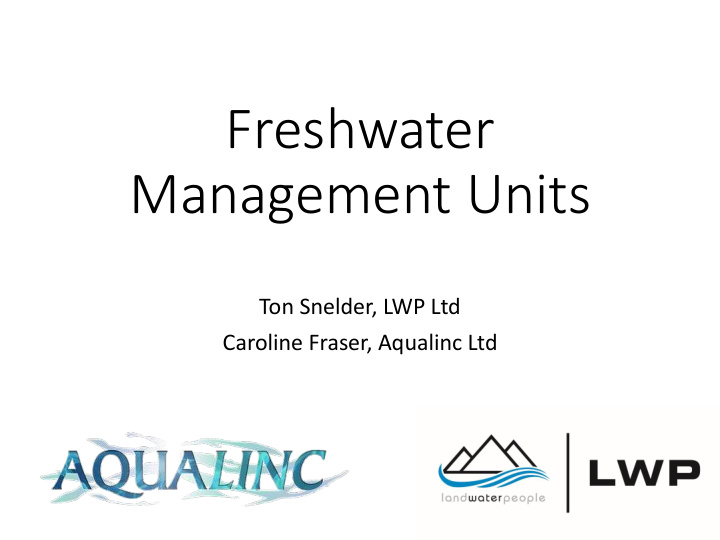



Freshwater Management Units Ton Snelder, LWP Ltd Caroline Fraser, Aqualinc Ltd
Outline 1. Definition and purpose of FMUs 2. Options for defining FMUs 3. A “network” approach to defining FMUs 4. Example of water quality FMUs based on Bay of Plenty region (BoP).
1. Definition and purpose • An inconvenient definition • NPS-FM definition of FMU: • “a water body, multiple water bodies, or any part of a water body determined by a regional council at the appropriate spatial scale for setting freshwater objectives and limits and for freshwater accounting and management purposes” • But • Values and objectives apply to the water body, • management and limits apply to its catchment • So • FMUs must comprise water bodies and their catchments ~ and scale is important!
Purpose of FMUs • Aspirations and appropriate management regimes differ across the Whaitua • FMUs are a spatial framework that provide for: • Variation in values • Variation in appropriate management regimes • FMUs also need to provide for different management functions: 1. setting objectives 2. defining policies and limits 3. accounting for resource use
FMUs define management regimes • Regional Plan provisions will apply to each FMU • Objectives, Policies, Limits and Rules • Plan provisions must be justifiable • The same regime must be justifiable within an FMU • Different FMUs may require different management regimes • We want a simple but robust plan • Therefore need a small but sufficient number of FMUs • Number of FMUs is a judgement: • Trade-off between specificity of the provisions and complexity of the plan • Ability to justify provisions (e.g., is there data describing current state)
2. Criteria for defining FMUs • Incorporate the water body and its catchment • Discriminate differences in values and “capacity for resource use” [ current state - water quality] • Basis for defining justifiable plan provisions (objectives and policies) • Practically monitored and administered • Provide plan clarity and certainty – boundaries. • Easily altered and revised as part of plan development • Need a “Goldilocks” number, not too many, nor too few
Data is limited Long term water quality monitoring sites in the Ruamahanga catchment
Options for defining FMUs 1. Water Management Areas, Zones, Whaitua 2. Sea-draining catchments 3. Ad hoc subdivision and grouping 4. Classification
a) Water Management Areas, Zones, Whaitua Socially coherent sub-regions.
Water quality in sub-regions • Water quality is variable at sub-region scale • values and “capacity for resource use” are variable at sub-region scale • sub-regions are too large and need to be subdivided Sub-regional area (BoP WMA)
b) Sea-draining catchments • Northland has many sea-draining catchments (1300) • Far too many to use as FMUs • small catchments need to be grouped • But large catchments need to be subdivided.
c) Ad-hoc subdivision of catchments Waikato’s FMUs
d) Bio-physical classification of the drainage network • S ubdivide large heterogeneous catchments • Group small similar sub-catchments • Based on specific criteria • natural factors that are relevant to the management of water quality and quantity. • e.g. topography and geology • Bio-physical classification • A baseplate for FMUs that can be altered, amended and added to • For example, additional classes to differentiate important social, cultural or economic differences
River Environment Classification (REC) 1. National bio-physical classification system 2. Developed by MFE 2002 3. Based on a digital river network
Mountain
Hill
Low Elevation
Classification used by other Regional Plans • REC classes are classifications of water bodies • FMU extends water body classification to include catchments
Bio-physical network classification approach Associated with: Three steps: 1. Determining current state 1. define a and setting objectives management (water bodies) classification, 2. defining policies and limits (land areas draining 2. define to water bodies belonging management to a particular zones, and management class) 3. define 3. accounting for resource administrative use (discrete sub- catchments) points.
Example water quality FMUs • Classification based on Catchment Geology + Catchment Slope. • Broadly discriminates water quality and values • Catchment Geology + Catchment Slope also broadly discriminates differences in hydrology (water quantity)
Proposed BoP management classes Non-Volcanic Hill Volcanic Hill Volcanic Low
Current state Non-Volcanic Hill Volcanic Hill Volcanic Low
Step 2. Define Management Zones Zones Classes Order 1.Non-Volcanic 2. Volcanic Hill 3. Volcanic Low Zones account for the most restrictive downstream objectives
POLICIES and LIMITS apply to Management Zones
Step 3. Define Administrative Points Downstream end of management zones: • Reconcile resource use with limits • Important w.r.t. consents • Not monitoring points
Benefits of this approach • Classification determines resolution of plan provisions - coarse or fine (simple or complex) • Easily modified (e.g. to make different or coarser/finer FMUs). • Transparent and clear - based on specific criteria • Inherent logic – • objectives apply to the water bodies • limits and actions apply to the catchments • Limits and actions set to achieve the most restrictive downstream objective
Benefits (continued) • Framework for implementation defined by the administrative points • consenting and accounting for resource use • appropriate levels of resolution • Efficient monitoring based on representative monitoring sites in each management class. • Spatially clear framework showing where: • objectives and policies apply • limits need to be met • where accounting should occur (administrative points)
THANK YOU
Recommend
More recommend